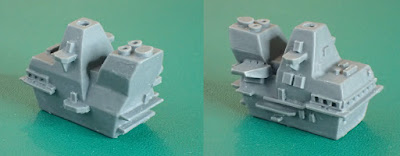HMS Warspite - Navis / Neptun Models and Memorabilia.

Like many British naval history enthusiasts, I have a particular fondness for the battleship HMS Warspite because of its long and remarkable career. A career that could so easily have ended prematurely at Jutland in 1916 but instead went right through to bombardment duty 28 years later off Normandy and Walcheren via Narvik, Calabria and Matapan and eventually ended on the rocks off Prussia Cove before the ship was finally broken up a short tow away, in the shadow of Saint Michael's Mount. There are already many accounts of that career so I won't try to make my own version. A good online summary is here , including photos of the grounding and final breaking up just off the beach at Marazion.. Of course Warspite was heavily reconstructed between the World Wars, radically changing her profile from a classic WW1 dreadnought through the addition of a massive tower bridge, single funnel and midships hanger. More significant if less obvious improvements were made to the propulsion, ar




